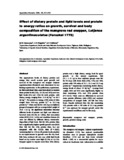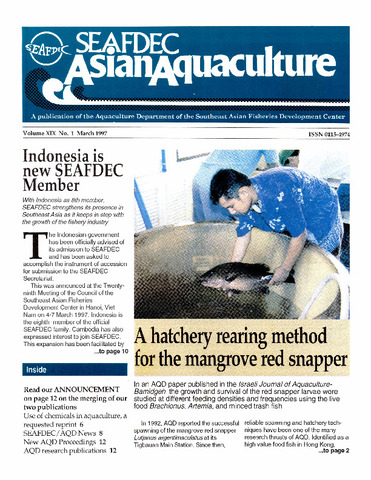Effect of dietary protein and lipid levels and protein to energy ratios on growth, survival and body composition of the mangrove red snapper, Lutjanus argentimaculatus (Forsskal 1775)
- Global styles
- MLA
- Vancouver
- Elsevier - Harvard
- APA
- Help
Share
Abstract
The approximate levels of dietary protein and energy that would sustain good growth and survival of the mangrove red snapper Lutjanus argentimaculatus (Forsskal) were determined in two feeding experiments. In the preliminary experiment, six fish meal-based diets were formulated to contain three protein levels (35%, 42.5% and 50%) and two lipid levels (6% and 12%) for each protein, with dietary energy ranging from 14.6 MJ kg−1 to 20.5 MJ kg−1. The protein to energy (P/E) ratios of diets ranged from 20.6 mg protein kJ−1 to 27.5 mg protein kJ−1. Diets were fed for 100 days to triplicate groups of snappers with an average initial weight of 24.8 ± 0.4 g. No significant interaction between different levels of protein and lipid was observed. Survival rates (93.8% to 100%), feed conversion ratios (FCR) (2.61–3.06) and condition factors (K) were not affected by different dietary treatments. Regardless of lipid level, fish fed 50% protein diets had a significantly higher specific growth rate (SGR) than fish fed the 35% protein diets, but not compared with the 42.5% diets (P < 0.05). Increasing lipid to 12% in all protein levels resulted in no improvement in growth over the 6% level. Fish body moisture did not vary while lipid levels based on dry matter were high (27.9% to 33.7%). Snapper appear to require more than 40% dietary protein and a high dietary energy level for good growth. In the second experiment, fish (21.1 ± 0.1 g) in four replicate groups were fed for 94 days with three diets (39%, 44% and 49% protein with P/E ratios of 21.1, 23.3 and 25.5 mg protein kJ−1 respectively) containing similar dietary energy levels of about 19 MJ kg−1. Average final weight, SGR and FCR were significantly higher in diets containing 44% and 49% protein diets (P > 0.05). There were no differences in survival rates, protein efficiency ratio (PER) and nutrient composition of snapper flesh. All fish had fatty livers. Results indicated that the diet containing 44% protein with a P/E ratio of 23.3 mg protein kJ−1 was optimum for snapper growth under the experimental conditions used in the study.
Suggested Citation
Catacutan, M. R., Pagador, G. E., & Teshima, S. (2001). Effect of dietary protein and lipid levels and protein to energy ratios on growth, survival and body composition of the mangrove red snapper, Lutjanus argentimaculatus (Forsskal 1775). Aquaculture Research , 32(10), 811-818. https://doi.org/10.1046/j.1365-2109.2001.00618.x
Type
ArticleISSN
1355-557XKoleksi
- Journal Articles [1258]
Related items
Showing items related by title, author, creator and subject.
-
Partial replacement of fishmeal by defatted soybean meal in formulated diets for the mangrove red snapper, Lutjanus argentimaculatus (Forsskal 1775)
Catacutan, Mae R.; Pagador, Gregoria E. (Blackwell Publishing, 2004)This study was conducted to evaluate the effect on growth and feed efficiencies of the mangrove red snapper (Lutjanus argentimaculatus) when dietary fishmeal is partially replaced by defatted soybean meal (DSM). In the ... -
A hatchery rearing method for the mangrove red snapper
Castaños, Milagros T.; Southeast Asian Fisheries Development Center, Aquaculture Department (Aquaculture Department, Southeast Asian Fisheries Development Center, 1997) -
Growth and feed efficiency in mangrove red snapper, (Lutjanus argentimaculatus Forsskal 1775) fed practical diets supplemented with L-ascorbyl-2-monophosphate-Mg
Catacutan, Mae R.; Pagador, Gregoria E.; Doyola-Solis, Ellen; Teshima, Shinichi; Ishikawa, Manabu (Society of Israeli Aquaculture and Marine Biotechnology (SIAMB), 2011)Growth and feed efficiency were determined in red snapper, Lutjanus argentimaculatus (Forsskal 1775), fed diets containing L-ascorbyl-2-monophosphate-Mg (AMP). Fish (13.39±0.08 g) were fed a practical diet without vitamin ...





